At the heart of any enduring brand are its key messages—those snippets of content and descriptors about your company and its products and services that get delivered consistently to your target audience through a variety of channels, bringing your brand to life in a way that appeals emotionally to customers and prospects.
These are not long messages of dense text, nor are they overly complicated explanations. Content that takes too long to get to the point will lose readers; people simply won’t take the time to read it or decipher it. Similarly, when messages are too complex, readers either won’t make an effort to understand or they’ll simply lose focus.
KEEP IT SIMPLE: LESS IS MORE
At most, your key messaging should contain those 3 to 5 things that the marketplace must know about your brand. Key messages should describe who you are, what you do, what differentiates you in the market, and highlight any products or services of distinction (such as ways you are disrupting your industry, new technology, innovative solutions, etc.).
Keep language direct and natural, as though you are engaging in conversation with someone. You may know all the reasons you have the most effective “widget” or are the best or most qualified to provide a particular service, but consumers don’t need to know every detail, just the important, top-level stuff. Longer, more in-depth explanations can be delivered via the fine print for those consumers who need such reassurance. Key messages, on the other hand, catch the eye and focus on the benefits to the consumer.
KEEP IT SMART: FOCUS ON THE BENEFIT
The intent behind your key messages is to communicate memorable statements about your brand to consumers in ways that address their pain points. Consumers look to you to solve specific problems or challenges. They are looking for the benefit(s) of using your product or service, not the features.
Therefore, your messaging must address how you are the “first,” “best,” or “most in-tune” with their needs. In one way or another, all of your consumer-facing messaging should revolve around this underlying theme: you (the consumer) have a need and we’re the ones who can solve it.
For example, while the claim “We’re the region’s largest law firm” may be factual, it’s unlikely to elicit many “oohs” and “ahhhs” from consumers unless their only criterion for selecting a law firm is the size of the practice. A statement such as “Our law firm has won the most judgments for our clients in the state over the last five years” is much more likely to capture the interest of someone looking to hire an attorney with a winning track record.
KEEP IT CONSISTENT: SING THE SAME TUNE
No matter what channels are used to deliver your key messages, it’s important that what is said or written about your company and its products and services remains consistent. This means that no matter where your messaging appears—a blog, social media post, CEO comment to the media, email signature, digital advertisement, your website, or verbiage on a work order or customer invoice—it should appear as though it originates from the same source and it should deliver the same message.
To achieve such consistency, many top brands create corporate messaging standards that are communicated to new hires through employee orientation and reinforced with existing staff over time. Many companies also have policies concerning social media posting, whether done on behalf of the company or by employees as individuals.
KEEP IT PEOPLE FRIENDLY
The purpose of your messaging is to engage people in a conversation about your brand so that they ultimately decide to purchase a product or service from you. That said, we can’t ignore that we live in an age of digital content, the delivery of which is driven to a large extent by search engine optimization (SEO). In other words, your great messaging needs to be found and heard by the audience you’re writing it for.
So as brands develop their key messages, content writers are often left wondering, “Do we write content that’s rich with keywords irresistible to Google? Do we write content that connects with consumers first and foremost? Or do we somehow do both?”
In my experience, the solution is to do a bit of both, but to tip the scales in the direction of being people friendly. After all, you are writing for people. Quality content that focuses on your 3 to 5 key messages should, by its very nature, include those keywords and phrases most important to your audience.
Think about it: if your write content with the main purpose of it being found and indexed by search engines, without regard to whether it actually engages your target audience, what good is that? Your content must both attract consumers and then convert them from prospects into customers. It’s simply not good enough to “drive traffic” to your website or blog only to turn visitors off with keyword rich, non-people friendly content.
It May Be Time to Outsource Your Marketing When…
What does your messaging tell your target audience about your brand? Does it make an emotional connection? Does it convert prospects into customers? Is it consistent across all channels?
CRAFT YOUR MESSAGES WITH BOM
Barrel O’Monkeyz has years of experience working with companies to develop and refine their brand stories, messaging, and content for websites, blogs, marketing, advertising, and more. We invite you to put our expertise in planning, strategy, digital marketing, social media, product development, ecommerce, website development, outbound and inbound marketing, content development, and branding to work for you as you ramp up sales, launch new products, and position or re-position your brand . Interested? Contact us today.

